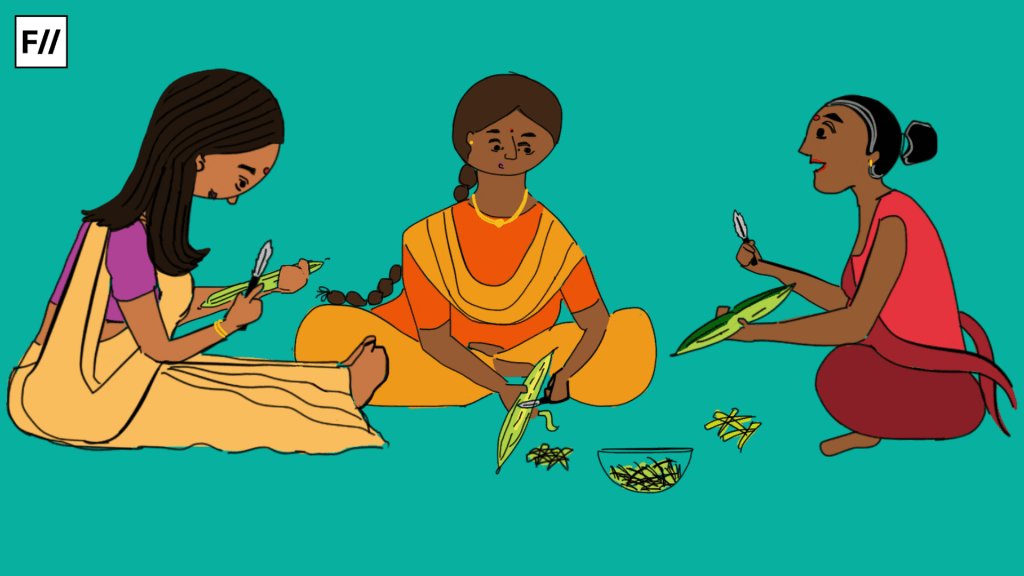Before delving into quantitative evidence about India’s agricultural productivity that is mainly carried out by women, it is significant to know the data released by the University of Maryland and The National Council of Applied Economic Research (NCAER, 2018) that claims women make up 42 per cent of the Agricultural Labour Force who have access to ownership of less than 2 per cent of land in the country.
In compliance with the last census of 2011, the government of India’s Ministry of Agriculture and Farmers Welfare talks through land use statistics that India’s geographical land is 328.7 million hectares, out of which 54.8 per cent is agricultural. It has even been recognised that agriculture and its allied activities accord people their primary source of livelihood. It is not just about 10-20 per cent of people engaged in agriculture, but 54.6 per cent are in agriculture and its allied activities. In line with the World Bank Collection of Development Indicators, India’s agricultural land forms 60.05 per cent.
There is a research report by Oxfam that says women are majorly engaged in agricultural activities but are still deprived of land ownership rights. It delineates “80 per cent of women in agriculture have the ownership of 13 per cent of land.”
Since women play a considerable role in agricultural production, they are even marginalised in the same field. Land serves as an economic asset that paves the way for their upliftment, including socio-political participation and importance in decision-making processes. Although they are forced to sell their labour power in production activities without even being recognised as land owners.
As gender roles are distributed, household management is meant for women. They are engaged in agriculture and are also supposed to manage household activities as unpaid labour. In simple words, a ‘double burden,’ is imposed on women. This double burden results in ‘mental health deterioration,’ among them. It gets worse when they belong to lowered caste-class groups.
According to a research analysis entitled “Mental Health of Rural Women” in rural areas, women are exposed to a barrage of challenges such as gender inequality, inequity, traditional roles of child caretakers, and agricultural workers that bring them depression, anxiety, somatisation and other disorders.
Marginalised based on gender, caste and class
Gender inequality and inequity loom large in rural areas in India. There is a huge marginalisation that prevails on the intersection of gender, class and caste that affects women’s mental health. There is a research study by the Foundation for Agrarian Studies that touches upon women’s composition in rural areas where 82 per cent of them as unpaid domestic workers are participants in agricultural activities.

Amid rumours being spread concerning the establishment of gender equality, it is imperative to realise that a country can’t embark on its development and growth without acknowledging the marginalisation of women and working towards their upliftment. It’s women who are forced to sell their labour power in household management as unpaid labourers and agricultural activities without even being recognised as farmers that further prevents them from holding on to institutional benefits. For example: government departments, banking etc.
In fact, in keeping with the last Census of 2011, women in agriculture were not accorded recognition of ‘farmers,’ but ‘cultivators.’ It should be taken into consideration that there is still a fight to meet the demand for the recognition of women as farmers. Even Mahila Kisan Adhikar Manch (MAKAAM) asserts that there is an invisiblisation of female farmers as a result of the inaccessibility of land ownership.
The word ‘farmer,’ has traditionally been linked with men. Do you remember the famous slogan “Jai Jawan, Jai Kisan?” Here, Jai Kisan is associated with male farmers, not females.
Furthermore, it is veracious that women are majorly engaged in agricultural productivity but it is also worth noticing that the majority of them belong to marginalised groups.
There is a research work named “Education, Social Exclusion and Inclusive Framework: A Perspective from Dalit Women” that mentions ‘triple deprivation,’ faced by Dalit women on the intersectionality of gender, caste and class. It is crystal clear to accept the vulnerability of Dalit women to sexual exploitation in rural areas. It is erroneous to think of the absence of bonded labour in present-day India. It still extensively prevails. Lowered-caste people are considered bonded agricultural workers in general and lowered-caste women in particular are even forced to satisfy the sexual desires of their high-caste landlords. There may be no direct participation of upper-caste women in agriculture.
In keeping with studies, there is a high prevalence rate among Dalit women for being direct participants in the same field. Veraciously, Dalits have historically been denied ownership of properties as they are placed at the bottom of the social hierarchy. Socially, they are considered erstwhile untouchables, and economically, they are deprived.
Henceforth, this deep-rooted social stratification invisiblises women which in turn, affects their mental health. Triple deprivation of gender inequality, social exclusion and poverty is not natural but human-made through the establishment of societal norms. It is high time to overcome prevailing views in our male-dominated society as regards the achievement of gender equality in all aspects. In practice, at the grassroots level, women are even engaged as low-paid workers in labour-intensive activities in agricultural fields such as cutting grass, separating seeds from fibre etc.
Women as agricultural labourers and domestic workers spawn mental health crisis
On the one hand, they are expected to work as unpaid domestic workers. On the other hand, they work as low-paid, landless workers in agriculture who further face discrimination based on caste that makes them susceptible to sexual exploitation. All these factors lead to mental health deterioration.

There is a research study named “Mental Health of Rural Women” that mentions the definition of mental health extracted from the WHO 1981 report, “Mental Health is the capacity of the individual, the group and the environment to interact with one another in ways that promote subjective well-being, the optimal development and use of mental abilities (cognitive, affective and relational), the achievement of individual and collective goals consistent with justice and the attainment and preservation of conditions of fundamental equality.” The research paper also asserts that the deprivation of rights among women in rural areas leads to mental stress. Excessive burden of work on them and invisiblisation of their work serve as primary stressors. At first, women are forced to sell their labour power at a cheap or no rate, then their work is frequently ignored or deemed an extension of their household management.
People may not be exposed to this in general as they lack consciousness about this but female rural workers suffer from Common Mental Disorders (CMDs) that encompass depression, suicide, anxiety etc.
The feminisation of agriculture and mental health
There is an official acceptance through the term ‘Feminisation of Agriculture,’ which explains the expansion of agricultural female workers and the main cause is male workers migrating to urban areas in pursuit of better job opportunities. But the point should be taken into account that there is enormous confinement of female workers to labour-intensive traditional roles. Being overburdened with responsibilities as household workers and farm workers, they are unable to control their lives.

All these factors give rise to stress, anxiety and depression. The absence of health care services adds severity to this. There is deteriorating mental health that is overlooked or ignored under the guise of the official term ‘Feminisation of Agriculture.’ So, it is high time to understand how gender inequality and inequity in agriculture trigger mental disorders.
About the author(s)
As a student of history at the University of Delhi, Nashra Rehman is always elated to share
her understanding of Gender History and an interlink between past and present. She is highly
passionate to inculcate in awakening minds pertaining to “How and Why women are
marginalised” through her publications.






